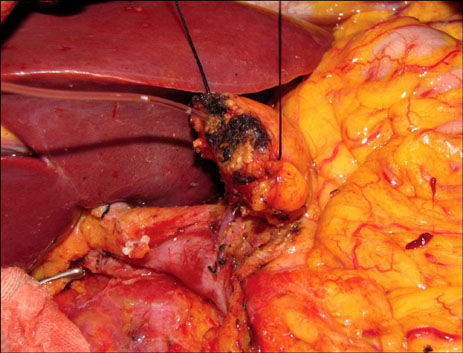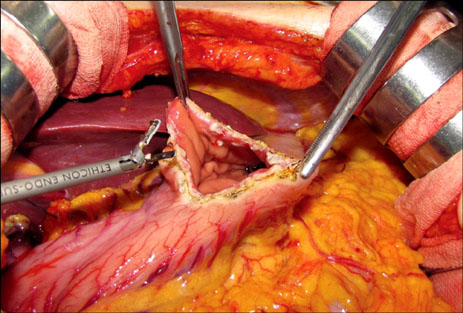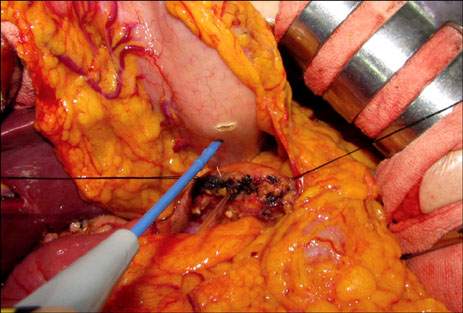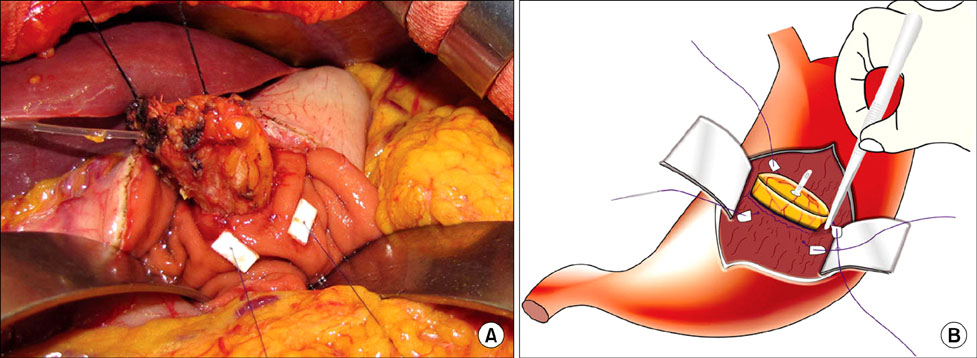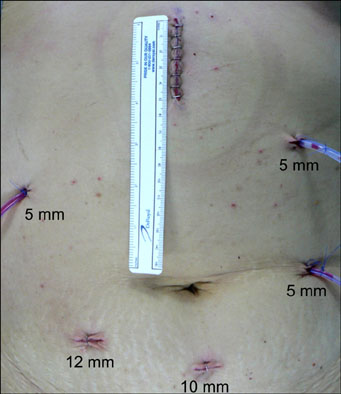J Korean Surg Soc.
2011 Nov;81(5):332-338. 10.4174/jkss.2011.81.5.332.
An easy and secure pancreaticogastrostomy after pancreaticoduodenectomy: transpancreatic suture with a buttress method through an anterior gastrotomy
- Affiliations
-
- 1Division of Hepatobiliary-Pancreas Surgery, Department of Surgery, Seoul St. Mary's Hospital, The Catholic University of Korea School of Medicine, Seoul, Korea. yky602@catholic.ac.kr
- 2Division of Hepatobiliary-Pancreas Surgery, Department of Surgery, Incheon St. Mary's Hospital, The Catholic University of Korea School of Medicine, Incheon, Korea.
- KMID: 2096687
- DOI: http://doi.org/10.4174/jkss.2011.81.5.332
Abstract
- PURPOSE
The aim of this report was to describe a new reconstructive technique of pancreaticogastrostomy and to also discuss this procedure's effectiveness for reducing the incidence of postoperative complications.
METHODS
We retrospectively analyzed early surgical outcomes in 21 consecutive patients who underwent this novel pancreaticogastrostomy after pancreaticoduodenectomy. Pancreaticogastrostomy was completed with 2 transpancreatic sutures with buttresses on both the upper and lower edges of the implanted pancreas through the retracted anterior gastrotomy.
RESULTS
Operative mortality was zero and morbidity was 23.8%. A significant pancreatic fistula occurred in 1 patient (4.7%; grade B).
CONCLUSION
This technique is very easy to perform, less traumatic to the pancreatic stump, can be performed through a mini-laparotomy due to good vision and straight sutures, and it is secure owing to anchoring of the invaginated pancreatic stump to the stomach's posterior wall with buttresses. The results of this pilot study indicate that the technique may provide a favorable outcome and could be an alternative method of pancreatoenteric anastomosis. However, to determine its superiority over the conventional procedures, this operative technique should be evaluated more comprehensively in a larger series.
MeSH Terms
Figure
Reference
-
1. Chen HW, Lai EC, Su SY, Cai YF, Zhen ZJ, Lau WY. Modified technique of pancreaticojejunal anastomosis with invagination following pancreaticoduodenectomy: a cohort study. World J Surg. 2008. 32:2695–2700.2. Zeng Q, Zhang Q, Han S, Yu Z, Zheng M, Zhou M. Efficacy of somatostatin and its analogues in prevention of postoperative complications after pancreaticoduodenectomy: a meta-analysis of randomized controlled trials. Pancreas. 2008. 36:18–25.3. Birkmeyer JD, Siewers AE, Finlayson EV, Stukel TA, Lucas FL, Batista I. Hospital volume and surgical mortality in the United States. N Engl J Med. 2002. 346:1128–1137.4. Sledziński Z, Kostro JZ, Zadrozny D, Pirski I, Lukiański M, Głowacki J. Results of pancreaticogastrostomy after pancreaticoduodenectomy in 159 consecutive cases. Pancreatology. 2008. 8:36–41.5. Payne RF, Pain JA. Duct-to-mucosa pancreaticogastrostomy is a safe anastomosis following pancreaticoduodenectomy. Br J Surg. 2006. 93:73–77.6. Aranha GV, Aaron JM, Shoup M. Critical analysis of a large series of pancreaticogastrostomy after pancreaticoduodenectomy. Arch Surg. 2006. 141:574–579.7. Yang YL, Xu XP, Wu GQ, Yue SQ, Dou KF. Prevention of pancreatic leakage after pancreaticoduodenectomy by modified child pancreaticojejunostomy. Hepatobiliary Pancreat Dis Int. 2008. 7:426–429.8. Lai EC, Lau SH, Lau WY. Measures to prevent pancreatic fistula after pancreatoduodenectomy: a comprehensive review. Arch Surg. 2009. 144:1074–1080.9. Kleespies A, Albertsmeier M, Obeidat F, Seeliger H, Jauch KW, Bruns CJ. The challenge of pancreatic anastomosis. Langenbecks Arch Surg. 2008. 393:459–471.10. Grobmyer SR, Kooby D, Blumgart LH, Hochwald SN. Novel pancreaticojejunostomy with a low rate of anastomotic failure-related complications. J Am Coll Surg. 2010. 210:54–59.11. Peng SY, Wang JW, Li JT, Mou YP, Liu YB, Cai XJ. Binding pancreaticojejunostomy-a safe and reliable anastomosis procedure. HPB (Oxford). 2004. 6:154–160.12. Ohigashi H, Ishikawa O, Eguchi H, Sasaki Y, Yamada T, Kishi K, et al. A simple and safe anastomosis in pancreaticogastrostomy using mattress sutures. Am J Surg. 2008. 196:130–134.13. Aranha GV, Hodul P, Golts E, Oh D, Pickleman J, Creech S. A comparison of pancreaticogastrostomy and pancreaticojejunostomy following pancreaticoduodenectomy. J Gastrointest Surg. 2003. 7:672–682.14. Bassi C, Falconi M, Molinari E, Salvia R, Butturini G, Sartori N, et al. Reconstruction by pancreaticojejunostomy versus pancreaticogastrostomy following pancreatectomy: results of a comparative study. Ann Surg. 2005. 242:767–771.15. Murakami Y, Uemura K, Hayashidani Y, Sudo T, Hashimoto Y, Nakagawa N, et al. No mortality after 150 consecutive pancreatoduodenctomies with duct-to-mucosa pancreaticogastrostomy. J Surg Oncol. 2008. 97:205–209.16. Rosso E, Bachellier P, Oussoultzoglou E, Scurtu R, Meyer N, Nakano H, et al. Toward zero pancreatic fistula after pancreaticoduodenectomy with pancreaticogastrostomy. Am J Surg. 2006. 191:726–732.17. Shinchi H, Takao S, Maemura K, Aikou T. A new technique for pancreaticogastrostomy for the soft pancreas: the transfixing suture method. J Hepatobiliary Pancreat Surg. 2006. 13:212–217.18. Bassi C, Butturini G, Salvia R, Crippa S, Falconi M, Pederzoli P. Open pancreaticogastrostomy after pancreaticoduodenectomy: a pilot study. J Gastrointest Surg. 2006. 10:1072–1080.19. Tran K, Van Eijck C, Di Carlo V, Hop WC, Zerbi A, Balzano G, et al. Occlusion of the pancreatic duct versus pancreaticojejunostomy: a prospective randomized trial. Ann Surg. 2002. 236:422–428.
- Full Text Links
- Actions
-
Cited
- CITED
-
- Close
- Share
- Similar articles
-
- A simple pancreaticojejunostomy technique for hard pancreases using only two transpancreatic sutures with buttresses: a comparison with the previous pancreaticogastrostomy and dunking methods
- A novel pancreaticogastrostomy method using only two transpancreatic sutures: early postoperative surgical results compared with conventional pancreaticojejunostomy
- Clinical outcomes and technical description of unstented end to side pancreaticogastrostomy by small posterior gastrotomy
- Effect of Buttress Graft in Anterior Fusion for Spinal Tuberculosis
- Conversion to pancreaticogastrostomy for salvage of disrupted pancreaticojejunostomy following pancreaticoduodenectomy

